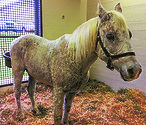Advertise Follow Us
Lamenesses
Research Journal: January/Febreuary 2016
The information, ideas and opinions expressed are those of the author and do not necessarily represent those of the United States Department of Agriculture.
Read More
Feeding Your Clients Good Nutritional Advice
Helping novice owners establish a solid foundation will help you maintain a healthy foot
Read More
Make an Informed Decision Before Packing a Foot
Understand when the materials are appropriate and when they’re not
Read More
Give the Frog Proper Attention
Illinois farrier spends a lot of time examining and trimming the frog, and for good reason
Read More
Considerations For Successful Management Of Underrun Heels
Two veterinarians and a farrier survey considerations for addressing this foot condition
Read More
Restricting Foot Slide Causes P1 Fractures
Study finds surfaces and traction devices present a higher injury risk
Read More
Preparation Is Key To Rebuilding Walls
New York farrier provides his insights into making the best of a tough task
Read More
What It Took to Make American Pharoah Go
Customizing a half plate shoe to protect a bruise paid off for the Triple Crown winner
Read More









